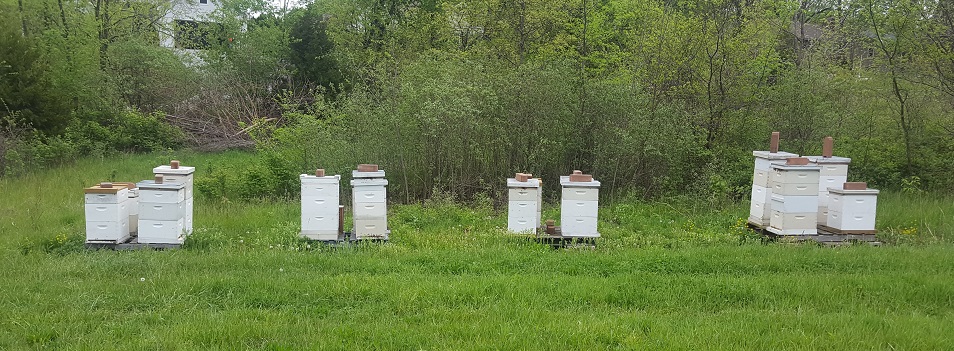Honeybee Swarm Capture and Hive Removal
What’s the difference between a swarm and a hive?
A swarm is a mass of bees normally from the size of a softball to the size of a couple of footballs that shows up suddenly to a location (hanging from a limb is quite normal) and stays for a few hours to a few days. They are a reproductive split off from a hive that is normally located up to a few hundred yards away and has gotten too big for the current location. Not getting into too much detail, it’s basically a homeless hive that’s looking for a good place to move into. The swarm is sending out scout bees and is reviewing all nearby opportunities. There is the possibility the swarm will move into a roof soffit, underneath a bay window or any medium size defendable uninsulated cavity they can find in a home.
Swarms are normally calm unless they’ve been there a while or bad weather is threatening and most importantly they are being provoked. Leave the swarm alone and call a local beekeeper as soon as possible. Once they move into a home that’s when things can get expensive so don’t delay calling a local beekeeper. I don’t normally charge for swarm removal unless it’s over 15 miles away and then it’s only enough money to cover the fuel costs but donations are always appreciated but not expected.
A hive is nest of honey bees. There will be comb, larva, and large amount of bees and honey. The longer they’ve been there the more of this there will be. If you want them removed the sooner you call the better for all involved. When doing a cut out, because it’s their home they have something to defend and defend they will. It’s very hard work, with stinging insects that fly added to the equation. These are time consuming to remove and thus it’s not without costs.
There are 2 way to remove hives. I physically remove the hive, called a “cut out” or trap the hive called a “trap out” from its location. A cut out is faster but more invasive and I do not offer repairs as I am not a carpenter. For a cut out it’s a minimum $400 and that covers 4 hours of work. After that it’s $50 per hour. A normal hive removal will take 4 hours to accomplish. The higher up or more dangerous the more the rate will go up and there are some cut outs I’ll refer to other high quality beekeepers who are better suited for certain challenges.
A trap out minimum charge is $200. I don’t normally do these on homes due to Small Hive Beetle issues than can arise and create a nightmare for all involved. The further away the trap out is the higher the charge as the main cost is travel time. I am normally visiting a trap out at least 10 times during the process. A hive trap out normally takes 8 weeks from start to finish. I install a cone on the entrance to the hive that allows the bees out but not back in. Next to this cone will be a small hive box (called a “nuc” for nucleus colony) with a frame of honeybee eggs and larva in it. Once the honeybee field workers realize they can’t get back into the original hive they will move into the small hive and some will assume nurse duties on the larva and eggs. They will turn some of the larva into a new queen for the small hive. Continually decreasing the field workers of the original colony and keeping new supplies from getting in will eventually decrease the honeybee population such that the original queen will abscond with the remaining population from the original hive. This normally occurs between 6-8 weeks from the date of the cone installation.
I visit the trap out regularly the first few days to ensure the bees aren’t finding a new way in. After that I’ll show up once a week to make sure the small hive is queen right and everything is functioning properly. I’ll remove the cone once the original hive is gone and the small hive will rob the original hive of all honey they can get. Once this is done be sure to foam fill the now abandoned honeybee cavity to ensure no new swarm moves in. Nothing attracts bees looking for a home like the smell of an unoccupied beehive.
Can’t I just kill the hive and save some money? Yes, you can. However, the honey, larva, dead bees, wax and pollen don’t just go away. They are magnets for ants, small hive beetles, silverfish, wax moths, flies, and cockroaches for years to come. Honeybees are also very important to the environment and are responsible for pollenating a substantial amount of the food grown in the US. Though not native to the Americas, honeybees are state insects of both Kansas and Missouri.
Is it a honeybee? Before you call about bees make sure what you’re looking at are indeed honey bees. Honeybees and many wasps/hornets remove their dead from their nest/hive and drop them outside the entrance. Go to the entrance at night and retrieve one to get a good look at it to make sure.
If still in doubt put a tablespoon of honey in a small saucer out about 5-10ft away from the entrance and put a tablespoon of honey on it. Honeybees will normally clean it up with great vigor whereas wasps/hornets will ignore it.
If it’s a honeybee and you want them removed don’t spray them with anything and call a beekeeper as soon as you can.
